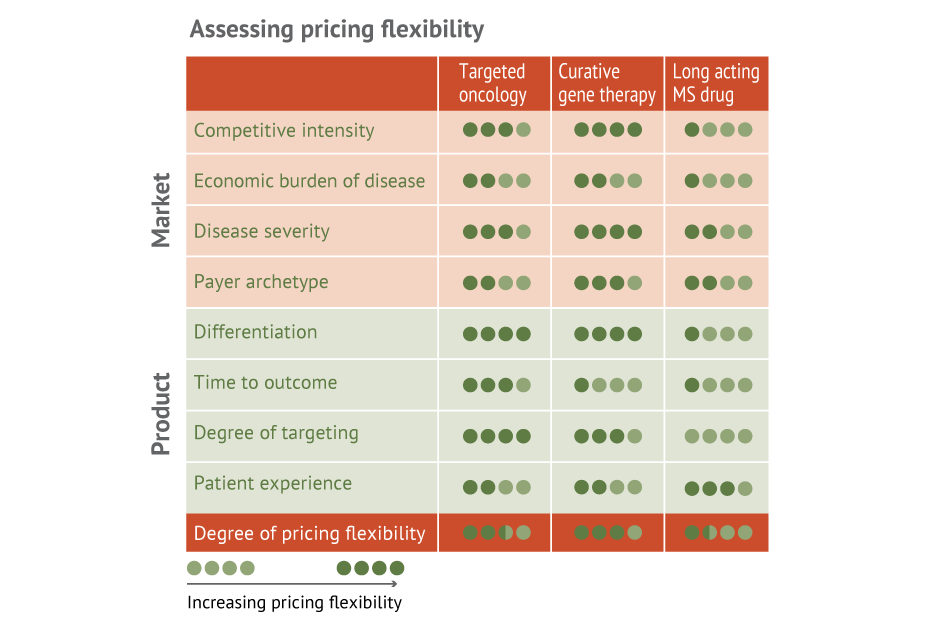Applying The Methodology
Executive Summary
Assessing the pricing flexibility of three different kinds of products: a genetically targeted oncologic, a curative gene therapy and a long-acting multiple sclerosis therapy that provides symptom relief.
In Exhibit 6, we assess the pricing flexibility of three different kinds of products: a genetically targeted oncologic, a curative gene therapy and a long-acting multiple sclerosis (MS) therapy that provides symptom relief. For each of the three products, we first assess eight factors independently, using the values of a traditional US commercial payer as our guide. Then, based on the pricing flexibility associated with each factor, we make a qualitative assessment of the overall pricing flexibility for each product type.
In the second step, we further refine the pricing analysis to reflect the actual competition in the marketplace. As noted, this is especially important if the novel product is launching into a heavily genericized space where “good enough,” cheaper medicines limit pricing flexibility. Finally, we link the individual product pricing strategy to the company’s larger commercial goals. By methodically evaluating the pricing decision at each of these levels, we identify which of the three products will benefit the most from innovative pricing strategies.
The MS medicine appears to have less pricing flexibility because of two critical market factors: competitive intensity (high) and the economic burden of disease (high). With numerous products available to treat the condition, payers and at-risk providers are more likely to be unconvinced of a new entrant’s worth relative to existing therapies. Similarly, the prevalence of multiple sclerosis means the economic burden of treating the disease will be greater than for a rare or niche disease. Hence, because of the potential budgetary impact associated with care, companies should anticipate needing to overcome payers’ skepticism with some kind of innovative pricing arrangement.
Exhibit 6
Assessing The Pricing Flexibility Of Three Different Products
Of the product-specific attributes, the MS medicine might result in payer skepticism due to its lack of targeting and a perceived lack of differentiation relative to the current standard of care. The medicine’s patient-friendly attributes will give it high value to certain stakeholders; others, however, will want to know if the drug’s dosing advantage translates into improved patient adherence and, therefore, better long-term outcomes.
An analysis of the prices of competing MS products suggests the novel entrant retains some, albeit limited, pricing flexibility. Although a large-molecule generic exists, the price differential between it and other marketed products isn’t so great that premium pricing could only be preserved via an innovative pricing scheme. Moreover, one of the unique attributes of the MS market is that stakeholders dislike switching stable patients to different agents, even when those medicines are much cheaper. That’s because there are costs, both economic and non-economic, associated with such a switch. (Patients will require additional physician oversight during this drug calibration period, for instance, to make sure their disease remains stable.)
Note the high switching cost associated with MS drugs also comes into play when the company aligns its pricing strategy to its overall commercial goals. With switching costs high, a new product is only likely to gain market share in newly diagnosed patients. To penetrate this “market” as quickly as possible, the company might want to consider an innovative pricing strategy that provides additional differentiation from existing therapies and allows the company to collect real-world data on the potential dosing advantage.
Despite the high cost associated with the novel oncologic, given the disease severity and the ability to narrow the population based on genetic information, this type of product should face little payer pushback in the US marketplace – at least until a competing product is introduced. Again, a pricing analysis of competing products provides little evidence that an innovative pricing arrangement is required. However, since oncology drugs are frequently used in combination, companies should be mindful of how the price of the individual drug may affect the cost of the treatment regimen overall. This is especially true if the regimen contains drugs from multiple pharmaceutical players, which might complicate the use of innovative pricing models. In this instance, the manufacturer will want to bolster its unit-based pricing decision with additional analytics that support the product’s value.
Of the three products we qualitatively assess, the curative gene therapy seems least likely to face payer scrutiny at launch. In this instance, the disease severity is high and the competitive intensity is low. Absent competing products in the marketplace, the product also enjoys only-in-class pricing flexibility. However, the durability of the therapy’s effectiveness is likely to be a concern for payers, especially if the price tag makes it difficult for payers to meet annual budgetary thresholds. Depending on the gene therapy’s cost, payers might desire some kind of pay-for-performance arrangement linked to the duration of the response.
Although the curative gene therapy is unlikely to require an innovative pricing arrangement at launch, a manufacturer could build considerable goodwill with stakeholders by considering other novel payment options. For instance, an innovative financing approach built on an annuity model would be one way to amortize the very significant up-front costs associated with the therapy. This strategy would provide cost-conscious payers with the budgetary certainty they need, while enabling patients access to a life-changing medicine.
